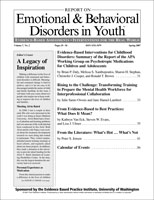Complete Issue
Author: Robert Stevens.; Mark D. Weist.
Source: Volume 17, Number 02, Spring 2017 , pp.29-54(26)

< previous article |return to table of contents
Abstract:
In this spring 2017 issue of EBDY, we present three examples of authentic partnerships assisting in improving SBH in dimensions of screening and implementation of effective programs within the multi-tiered system of support (MTSS) involving promotion/prevention (Tier 1), early intervention (Tier 2), and intervention (Tier 3). First, Becky Siceloff, Josh Bradley, and Kate Flory from the University of South Carolina (USC) provide background on universal behavioral health screening and discuss a four-way partnership among USC staff, a school district, and parents and families, working with support and guidance from a federal cooperative agreement to accomplish screening in a rural community. Pragmatic strategies for building relationships and moving toward a true partnership are emphasized, including “openness, willingness to work together, and acknowledgement of . . . expertise” of school staff and families. The article underscores how scientific accomplishments, in this case documenting community-wide data on emotional/behavioral problems in youth, rest upon collaborative relationships and partnerships. Mina Ratkalkar and colleagues from Drexel and Temple universities and the Northern Home for Children in Philadelphia discuss the Promoting Healthy Development through Effective Practices (PHDEP) program, an adaptation of the Incredible Years program focused on promoting social, emotional, and behavioral competencies among young children. Their article provides background on, and an outstanding example of, a partnership between a university and school system, with teachers collaboratively implementing the program along with graduate students in psychology, who provide critically needed hands-on support for the teachers and gain an excellent learning experience by implementing an evidence-based program in schools. The article also underscores that such collaborative relationships help to build capacity for effective measurement and intervention implementation, increasing the likelihood of achieving valued outcomes. The third article, by Bob Stevens, of the Medical University of South Carolina, Coach John Farrelly, of the Charleston County School District, and Ashley Quell, from USC, presents findings from a program evaluation of a Tier 2 afterschool program focused on teaching at-risk students skills in tennis, integrated with PBIS principles and a PBIS program implemented in the school. The evaluation/pilot study documents advantages of Tier 2 early intervention across contexts (i.e., school and tennis court) and the promise of integrating athletic involvement into PBIS programming. Support for the program from the United States Tennis Association is notable, and this pilot study points to a range of research and practice opportunities in enhancing PBIS-athletic connections for other sports.Keywords: Universal Behavioral/Emotional Health Screening in Schools; Classroom-Based Universal Social-Emotional Intervention Programs
Affiliations:
1: South Carolina Association for Positive Behavior Support Network; 2: University of South Carolina.